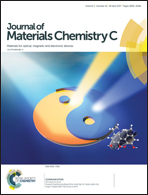The first author of a 2013 chemistry paper is objecting to his co-authors’ decision to retract the paper, which contains duplicated figures.
We recently encountered a similar scenario with papers by first author Khalid Mahmood. In late 2015, Mahmood lost three papers in the journal ACS Applied Materials & Interfaces over duplicated images. One of the notices also indicated that the figures had “been published elsewhere and identified with different samples” — the same language used in the notice of the most recent retraction, in Journal of Materials Chemistry C.
Mahmood performed the work on the papers at Korea Advanced Institute of Science and Technology (KAIST), along with his two co-authors, Seung Bin Park and Hyung Jin Sung (also co-authors on two of the retracted papers in ACS Applied Materials & Interfaces).
Seung Bin Park, who is dean of the College of Engineering at KAIST, told us:
I was deeply disappointed and distressed by this retraction … It was a period of time when joy of sharing new findings turned into nightmare.
Park said he did not know why Mahmood opposed this retraction, but noted:
I just hope that, someday, he comes out and gives explanation on his papers. He owes apology to his colleague[s].
Here’s the retraction notice for the 2013 paper:
We, Seung Bin Park and Hyung Jin Sung wholly retract this Journal of Materials Chemistry C article, on the basis of uncertainties regarding the validity of the SEM images, which have been published elsewhere and identified with different samples. Specifically; Fig. 1c in this Journal of Materials Chemistry C article, identified as In-doped ZnO, is the same image as Fig. 2 of our previous paper,1 where it is identified as 5% N-doped ZnO. Fig. 2c in this Journal of Materials Chemistry C article, labelled as pure ZnO, is also part of Fig. 2 of the same paper,1 where it is labelled as 3% N-doped ZnO. In addition, within this Journal of Materials Chemistry C article, Fig. 1b is the same image as Fig. 2b, whereas they are labelled differently as In-doped ZnO and pure ZnO, respectively. Finally, similarity between the noise in the XPS data in Fig. 5b, in this Journal of Materials Chemistry C article, and those in Fig. 3a reported in ref. 2, cast doubt on the validity of the XPS data.
Signed: Seung Bin Park and Hyung Jin Sung
10th February 2017Khalid Mahmood opposes this retraction and remains in support of the reported conclusions as they stand.
Retraction endorsed by Fiona McKenzie, Executive Editor, Journal of Materials Chemistry C
“Enhanced photoluminescence, Raman spectra and field-emission behavior of indium-doped ZnO nanostructures,” has been cited 51 times since it was published in 2013, according to Clarivate Analytics’ Web of Science, formerly part of Thomson Reuters. The first reference cited by the notice is one of the three previous retractions; the retraction notice for “Fabrication of Tantalum and Nitrogen Codoped ZnO (Ta, N‐ZnO) Thin Films Using the Electrospay: Twin Applications as an Excellent Transparent Electrode and a Field Emitter,” issued in 2015, also mentions duplicated images in the recently retracted paper.
Executive editor Fiona McKenzie declined to provide additional information:
The reasons for the retraction are explained in the retraction notice and our correspondence with the authors remains confidential.
We emailed Mahmood at KAIST, as well as King Abdullah University of Science and Technology in Saudi Arabia, where he was a postdoc, but have not heard back.
Like Retraction Watch? Consider making a tax-deductible contribution to support our growth. You can also follow us on Twitter, like us on Facebook, add us to your RSS reader, sign up on our homepage for an email every time there’s a new post, or subscribe to our new daily digest. Click here to review our Comments Policy.
